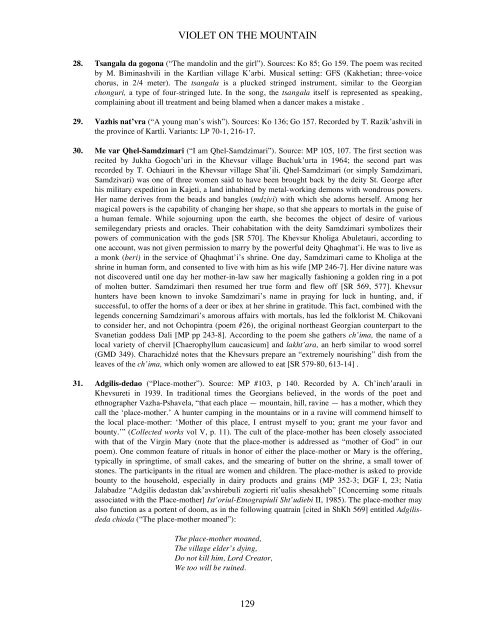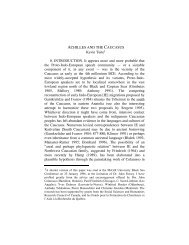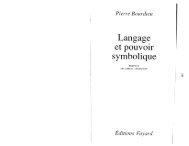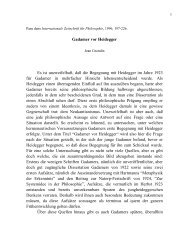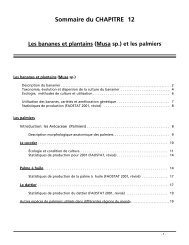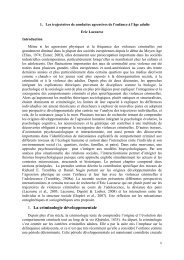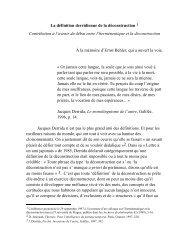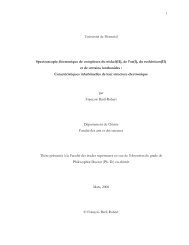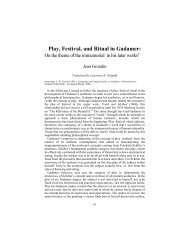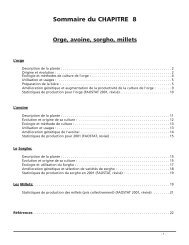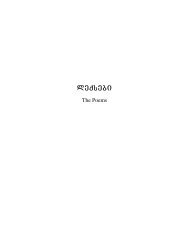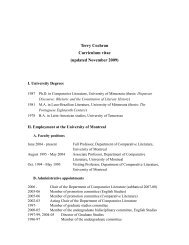Create successful ePaper yourself
Turn your PDF publications into a flip-book with our unique Google optimized e-Paper software.
VIOLET ON THE MOUNTAIN<br />
28. Tsangala da gogona (“The mandolin and the girl”). Sources: Ko 85; Go 159. The poem was recited<br />
by M. Biminashvili in the Kartlian village K’arbi. Musical setting: GFS (Kakhetian; three-voice<br />
chorus, in 2/4 meter). The tsangala is a plucked stringed instrument, similar to the Georgian<br />
chonguri, a type of four-stringed lute. In the song, the tsangala itself is represented as speaking,<br />
complaining about ill treatment and being blamed when a dancer makes a mistake .<br />
29. Vazhis nat’vra (“A young man’s wish”). Sources: Ko 136; Go 157. Recorded by T. Razik’ashvili in<br />
the province of Kartli. Variants: LP 70-1, 216-17.<br />
30. Me var Qhel-Samdzimari (“I am Qhel-Samdzimari”). Source: MP 105, 107. The first section was<br />
recited by Jukha Gogoch’uri in the Khevsur village Buchuk’urta in 1964; the second part was<br />
recorded by T. Ochiauri in the Khevsur village Shat’ili. Qhel-Samdzimari (or simply Samdzimari,<br />
Samdzivari) was one of three women said to have been brought back by the deity St. George after<br />
his military expedition in Kajeti, a land inhabited by metal-working demons with wondrous powers.<br />
Her name derives from the beads and bangles (mdzivi) with which she adorns herself. Among her<br />
magical powers is the capability of changing her shape, so that she appears to mortals in the guise of<br />
a human female. While sojourning upon the earth, she becomes the object of desire of various<br />
semilegendary priests and oracles. Their cohabitation with the deity Samdzimari symbolizes their<br />
powers of communication with the gods [SR 570]. The Khevsur Kholiga Abuletauri, according to<br />
one account, was not given permission to marry by the powerful deity Qhaqhmat’i. He was to live as<br />
a monk (beri) in the service of Qhaqhmat’i’s shrine. One day, Samdzimari came to Kholiga at the<br />
shrine in human form, and consented to live with him as his wife [MP 246-7]. Her divine nature was<br />
not discovered until one day her mother-in-law saw her magically fashioning a golden ring in a pot<br />
of molten butter. Samdzimari then resumed her true form and flew off [SR 569, 577]. Khevsur<br />
hunters have been known to invoke Samdzimari’s name in praying for luck in hunting, and, if<br />
successful, to offer the horns of a deer or ibex at her shrine in gratitude. This fact, combined with the<br />
legends concerning Samdzimari’s amorous affairs with mortals, has led the folklorist M. Chikovani<br />
to consider her, and not Ochopintra (poem #26), the original northeast Georgian counterpart to the<br />
Svanetian goddess Dali [MP pp 243-8]. According to the poem she gathers ch’ima, the name of a<br />
local variety of chervil [Chaerophyllum caucasicum] and lakht’ara, an herb similar to wood sorrel<br />
(GMD 349). Charachidzé notes that the Khevsurs prepare an “extremely nourishing” dish from the<br />
leaves of the ch’ima, which only women are allowed to eat [SR 579-80, 613-14] .<br />
31. Adgilis-dedao (“Place-mother”). Source: MP #103, p 140. Recorded by A. Ch’inch’arauli in<br />
Khevsureti in 1939. In traditional times the Georgians believed, in the words of the poet and<br />
ethnographer Vazha-Pshavela, “that each place — mountain, hill, ravine — has a mother, which they<br />
call the ‘place-mother.’ A hunter camping in the mountains or in a ravine will commend himself to<br />
the local place-mother: ‘Mother of this place, I entrust myself to you; grant me your favor and<br />
bounty.’” (Collected works vol V, p. 11). The cult of the place-mother has been closely associated<br />
with that of the Virgin Mary (note that the place-mother is addressed as “mother of God” in our<br />
poem). One common feature of rituals in honor of either the place-mother or Mary is the offering,<br />
typically in springtime, of small cakes, and the smearing of butter on the shrine, a small tower of<br />
stones. The participants in the ritual are women and children. The place-mother is asked to provide<br />
bounty to the household, especially in dairy products and grains (MP 352-3; DGF I, 23; Natia<br />
Jalabadze “Adgilis dedastan dak’avshirebuli zogierti rit’ualis shesakheb” [Concerning some rituals<br />
associated with the Place-mother] Ist’oriul-Etnograpiuli Sht’udiebi II, 1985). The place-mother may<br />
also function as a portent of doom, as in the following quatrain [cited in ShKh 569] entitled Adgilisdeda<br />
chioda (“The place-mother moaned”):<br />
The place-mother moaned,<br />
The village elder’s dying,<br />
Do not kill him, Lord Creator,<br />
We too will be ruined.<br />
129


